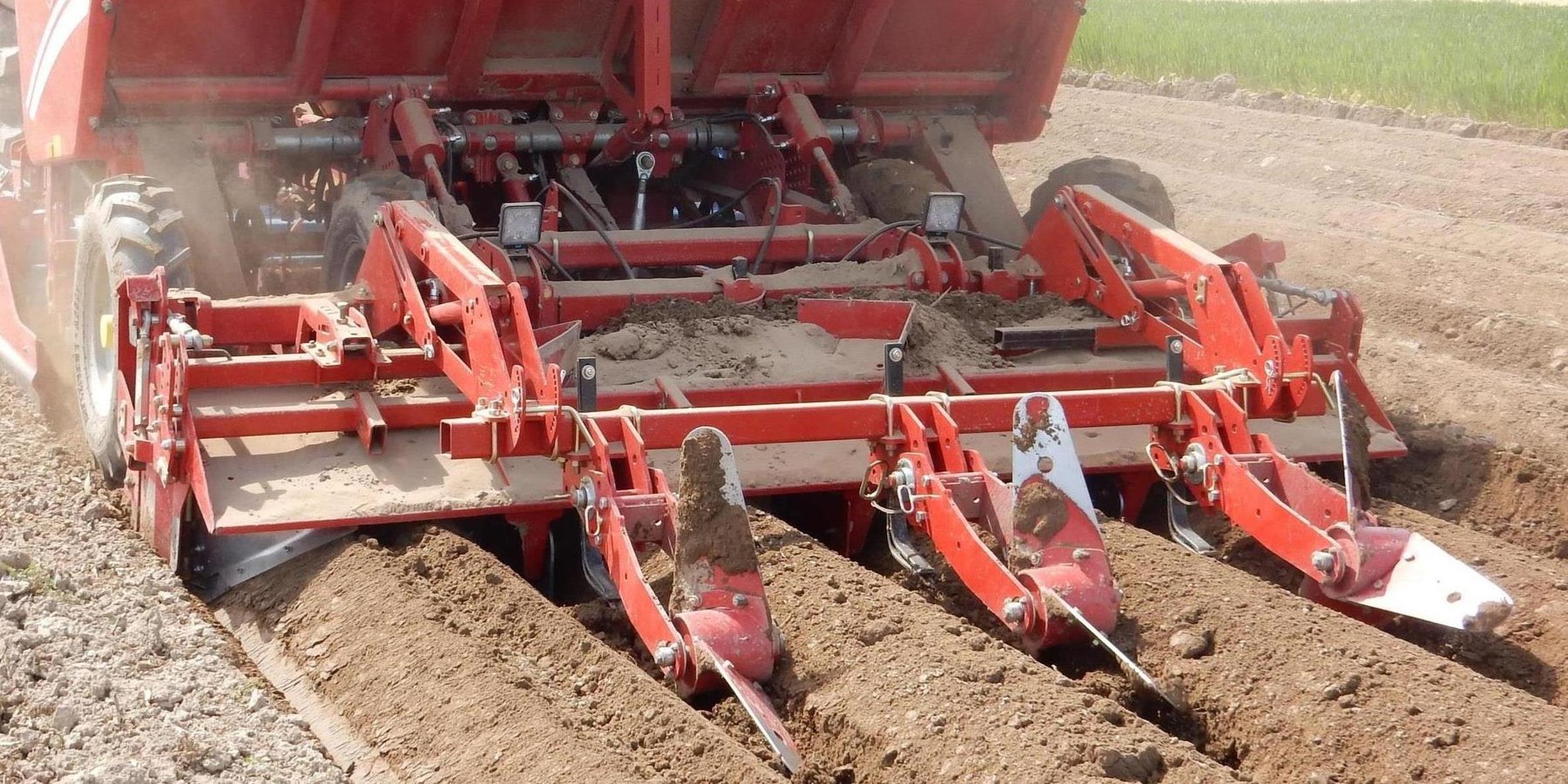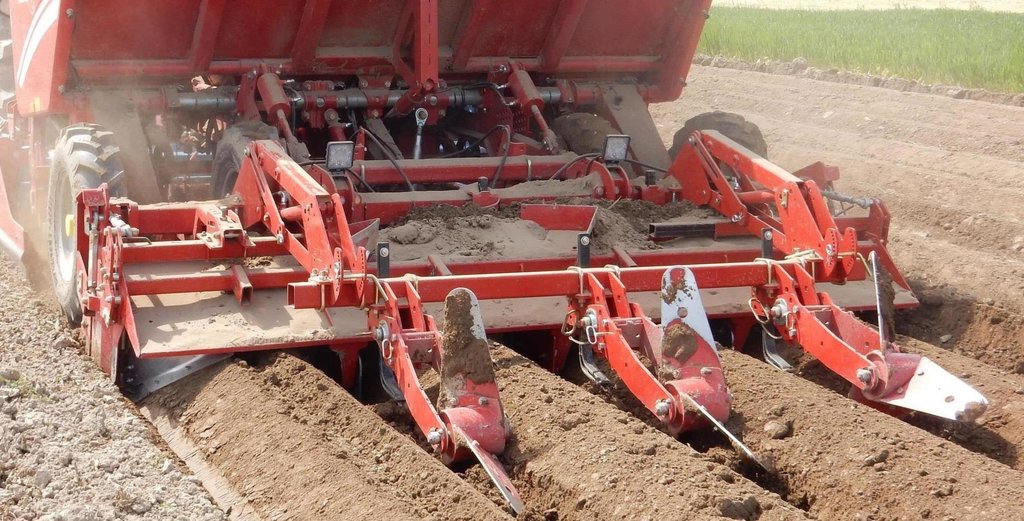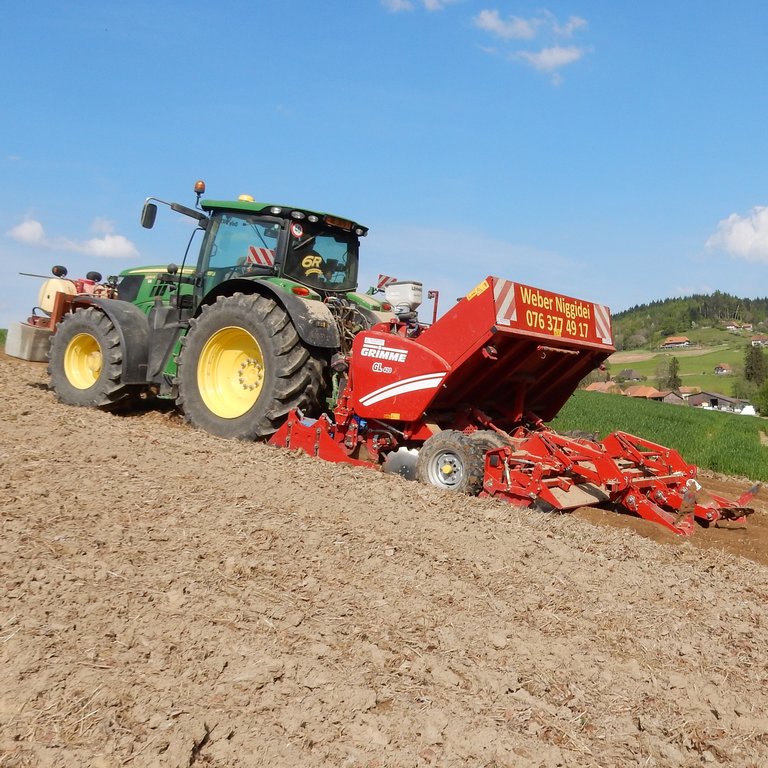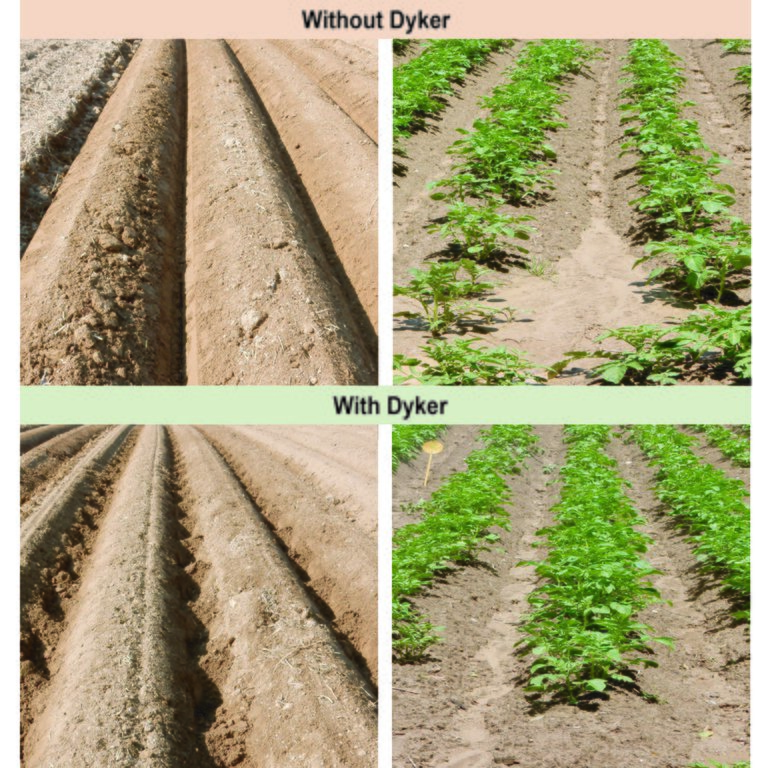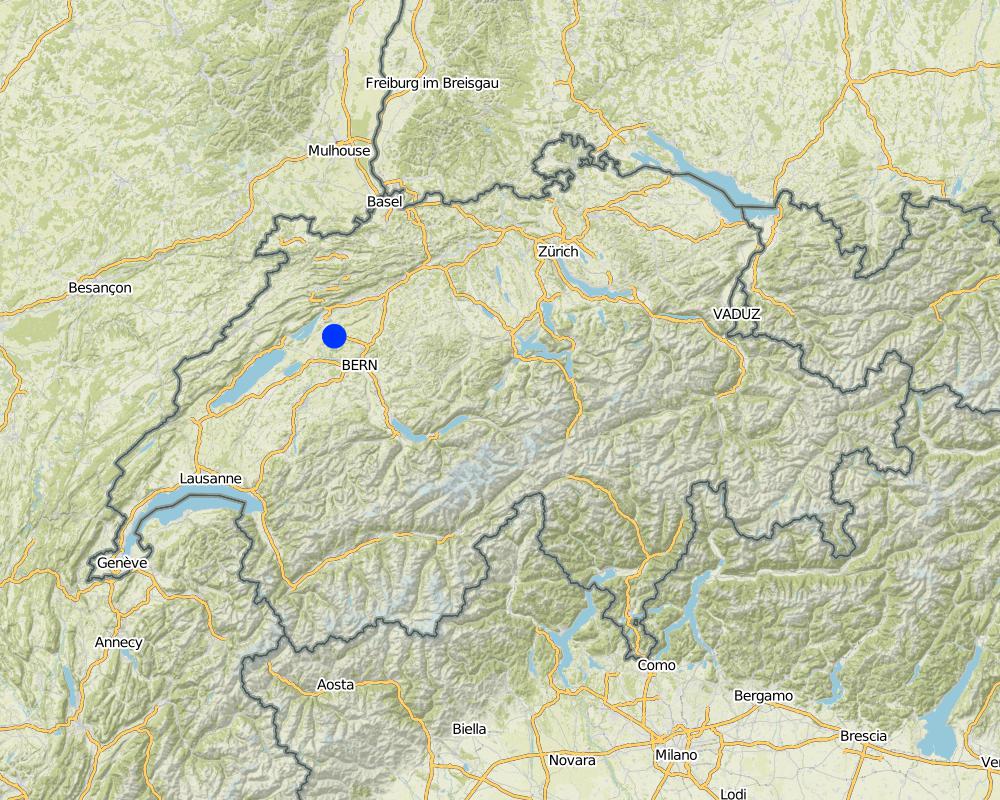Dyker System [瑞士]
- 创建:
- 更新:
- 编制者: Deborah Niggli
- 编辑者: –
- 审查者: Tatenda Lemann, Alexandra Gavilano
Dyker-System (oder Lochstern) im Kartoffelanbau
technologies_1304 - 瑞士
查看章节
全部展开 全部收起1. 一般信息
1.2 参与该技术评估和文件编制的资源人员和机构的联系方式
有助于对技术进行记录/评估的项目名称(如相关)
Preventing and Remediating degradation of soils in Europe through Land Care (EU-RECARE )有助于对技术进行记录/评估的机构名称(如相关)
CDE Centre for Development and Environment (CDE Centre for Development and Environment) - 瑞士1.3 关于使用通过WOCAT记录的数据的条件
编制者和关键资源人员接受有关使用通过WOCAT记录数据的条件。:
是
1.4 所述技术的可持续性声明
这里所描述的技术在土地退化方面是否存在问题,导致无法被认为是一种可持续的土地管理技术?:
否
2. SLM技术的说明
2.1 技术简介
技术定义:
The Dyker consists of a set of wheels with three to four inclined shovels each. Attached to the rear end of the planting machine, it digs holes into the bottom of the furrows between the potato hills.
2.2 技术的详细说明
说明:
The Dyker system consists of a new tractor trailer for cultivating potatoes. It was established by Grimme from Germany. With this new technology small holes and micro-dams are built in the furrows between the potato hills. They are intended to improve water infiltration and to help retain water near the plants, while preventing waterlogging and stagnant water in depressions and minimizing surface runoff and soil erosion.
On conventionally farmed potato fields (where an all-in-one potato planter can be used) no additional working steps are necessary and the Dyker can be used simultaneously with the potato planting machine. This saves time and money. For other crops or if no all-in-one potato planter is used, the Dyker can also be attached to a tractor as an individual trailer (without potato planter). Then one ore more additional working steps are needed after plantation.
The system is intended to prevent soil erosion and waterlogging during the cultivation process of potatoes. Furrows running parallel to the gradient are mostly endangered by soil erosion during the first 4-8 weeks until soil cover reaches a certain percentage. Small holes and micro-dams in the furrows increase infiltration and reduce surface runoff and thereby prevent soil erosion and water logging.
2.3 技术照片
2.4 技术视频
注释、简短说明:
The Dyker in use with a Grimme GL 420 potato planter
日期:
07/05/2016
位置:
Frienisberg
摄影师的名字:
Tatenda Lemann
2.5 已应用该技术的、本评估所涵盖的国家/地区/地点
国家:
瑞士
区域/州/省:
Wiler bei Seedorf
有关地点的进一步说明:
Bern
具体说明该技术的分布:
- 均匀地分布在一个区域
如果不知道精确的区域,请注明大致覆盖的区域:
- < 0.1 平方千米(10 公顷)
Map
×2.6 实施日期
如果不知道确切的年份,请说明大概的日期:
- 不到10年前(最近)
2.7 技术介绍
- through contructors' innovation
3. SLM技术的分类
3.1 该技术的主要目的
- 改良生产
- 减少、预防、恢复土地退化
3.2 应用该技术的当前土地利用类型

农田
- 一年一作
年作 - 具体指明作物:
- 根/块茎作物 - 土豆
每年的生长季节数:
- 1
注释:
Major land use problems (land users’ perception): The major land use problem is soil erosion by water occuring mainly at hillside situations. Land use problems related to the use of the plow are only minor because most of the land users have shifted to direct seeding, mulching or strip tillage.
3.4 供水
该技术所应用土地的供水:
- 雨养
3.5 该技术所属的SLM组
- 横坡措施
- 引水和排水
3.6 包含该技术的可持续土地管理措施

农艺措施
- A3:土壤表面处理
- A4:地表下处理
3.7 该技术强调的主要土地退化类型

土壤水蚀
- Wt:表土流失/地表侵蚀
3.8 防止、减少或恢复土地退化
具体数量名该技术与土地退化有关的目标:
- 防止土地退化
4. 技术规范、实施活动、投入和成本
4.1 该技术的技术图纸
技术规范(与技术图纸相关):
Technical knowledge required for field staff / advisors: moderate
Technical knowledge required for land users: high
Main technical functions:
-control of concentrated runoff: retain / trap,
-control of concentrated runoff: impede / retard,
-control of concentrated runoff: drain / divert
Secondary technical functions:
-reduction of slope length,
-increase of infiltrationgth, increase of infiltration
4.2 有关投入和成本计算的一般信息
具体说明成本和投入是如何计算的:
- 每个技术单元
指定单位:
Dyker (attachment for tractor or potato planter)
其它/国家货币(具体说明):
CHF
如相关,注明美元与当地货币的汇率(例如1美元=79.9巴西雷亚尔):1美元=:
1.0
4.3 技术建立活动
| 活动 | 时间(季度) | |
|---|---|---|
| 1. | Dyker system usage during cultivation of potatoes | During or after potato plantation |
4.4 技术建立所需要的费用和投入
| 对投入进行具体说明 | 单位 | 数量 | 单位成本 | 每项投入的总成本 | 土地使用者承担的成本% | |
|---|---|---|---|---|---|---|
| 劳动力 | Labour | days/year | 2.0 | 250.0 | 500.0 | |
| 设备 | Dyker | piece | 1.0 | 8500.0 | 8500.0 | |
| 技术建立所需总成本 | 9000.0 | |||||
| 技术建立总成本,美元 | 9000.0 | |||||
如果土地使用者负担的费用少于100%,请注明由谁负担其余费用:
Depending if the Dyker belongs to the farmer or a contractor
注释:
Standard costs for potato plantation like seeds and fertilizer, herbicide and pesticide are not included in the calculations for the costs. It is assumed that the Dyker is used with an "all-in-one" potato planter where no additional working steps are required.
In many cases the Dyker belongs to a contractor, who is planting potatoes for the farmers. In this case no additional costs can be expected for the farmers. The farmers only have to pay for the labour (contractor), seeds and fertilizer, herbicide and pesticide but not for the usage of the Dyker.
4.7 影响成本的最重要因素
描述影响成本的最决定性因素:
- If the Dyker belongs to a contractor with a all-in-one potato planter, no additional costs are expected for the farmer (but for the contractor)
- If the Dyker is not attached to a all-in-one potato planter but e.g. to a tractor, additional working steps are necessary.
5. 自然和人文环境
5.1 气候
年降雨量
- < 250毫米
- 251-500毫米
- 501-750毫米
- 751-1,000毫米
- 1,001-1,500毫米
- 1,501-2,000毫米
- 2,001-3,000毫米
- 3,001-4,000毫米
- > 4,000毫米
农业气候带
- 半湿润
Thermal climate class: temperate
5.2 地形
平均坡度:
- 水平(0-2%)
- 缓降(3-5%)
- 平缓(6-10%)
- 滚坡(11-15%)
- 崎岖(16-30%)
- 陡峭(31-60%)
- 非常陡峭(>60%)
地形:
- 高原/平原
- 山脊
- 山坡
- 山地斜坡
- 麓坡
- 谷底
垂直分布带:
- 0-100 m a.s.l.
- 101-500 m a.s.l.
- 501-1,000 m a.s.l.
- 1,001-1,500 m a.s.l.
- 1,501-2,000 m a.s.l.
- 2,001-2,500 m a.s.l.
- 2,501-3,000 m a.s.l.
- 3,001-4,000 m a.s.l.
- > 4,000 m a.s.l.
说明该技术是否专门应用于:
- 不相关
5.3 土壤
平均土层深度:
- 非常浅(0-20厘米)
- 浅(21-50厘米)
- 中等深度(51-80厘米)
- 深(81-120厘米)
- 非常深(> 120厘米)
土壤质地(表土):
- 中粒(壤土、粉土)
土壤质地(地表以下> 20厘米):
- 中粒(壤土、粉土)
表土有机质:
- 中(1-3%)
如有可能,附上完整的土壤描述或具体说明可用的信息,例如土壤类型、土壤酸碱度、阳离子交换能力、氮、盐度等。:
Soil texture is medium
Soil fertility is high
Soil drainage infiltration is medium
Soil water storage capacity is medium
5.4 水资源可用性和质量
地下水位表:
5-50米
地表水的可用性:
好
水质(未处理):
良好饮用水
水的盐度有问题吗?:
否
该区域正在发生洪水吗?:
否
5.5 生物多样性
物种多样性:
- 高
5.6 应用该技术的土地使用者的特征
定栖或游牧:
- 定栖的
生产系统的市场定位:
- 商业/市场
非农收入:
- 收入的10-50%
相对财富水平:
- 丰富
个人或集体:
- 个人/家庭
机械化水平:
- 机械化/电动
性别:
- 男人
土地使用者的年龄:
- 儿童
说明土地使用者的其他有关特征:
Land users applying the Technology are mainly leaders / privileged
5.7 应用该技术的土地使用者使用的平均土地面积
- < 0.5 公顷
- 0.5-1 公顷
- 1-2 公顷
- 2-5公顷
- 5-15公顷
- 15-50公顷
- 50-100公顷
- 100-500公顷
- 500-1,000公顷
- 1,000-10,000公顷
- > 10,000公顷
这被认为是小规模、中规模还是大规模的(参照当地实际情况)?:
- 中等规模的
5.8 土地所有权、土地使用权和水使用权
土地所有权:
- 个人,有命名
土地使用权:
- 个人
用水权:
- 个人
5.9 进入服务和基础设施的通道
健康:
- 贫瘠
- 适度的
- 好
教育:
- 贫瘠
- 适度的
- 好
技术援助:
- 贫瘠
- 适度的
- 好
就业(例如非农):
- 贫瘠
- 适度的
- 好
市场:
- 贫瘠
- 适度的
- 好
能源:
- 贫瘠
- 适度的
- 好
道路和交通:
- 贫瘠
- 适度的
- 好
饮用水和卫生设施:
- 贫瘠
- 适度的
- 好
金融服务:
- 贫瘠
- 适度的
- 好
6. 影响和结论性说明
6.1 该技术的现场影响
社会经济效应
生产
作物生产
生产故障风险
收入和成本
工作量
注释/具体说明:
When used with potato planter not additional work step needed. Workload is slightly increasing due to preparation of the Dyker.
社会文化影响
SLM/土地退化知识
冲突缓解
生态影响
水循环/径流
地表径流
土壤
土壤流失
其它生态影响
Hazard towards adverse events
6.2 该技术的场外影响已经显现
下游洪水
对邻近农田的破坏
6.3 技术对渐变气候以及与气候相关的极端情况/灾害的暴露和敏感性(土地使用者认为的极端情况/灾害)
渐变气候
渐变气候
| 季节 | 增加或减少 | 该技术是如何应对的? | |
|---|---|---|---|
| 年温度 | 增加 | 好 |
气候有关的极端情况(灾害)
气象灾害
| 该技术是如何应对的? | |
|---|---|
| 局地暴雨 | 未知 |
水文灾害
| 该技术是如何应对的? | |
|---|---|
| 比较和缓的(河道)洪水 | 不好 |
6.4 成本效益分析
技术收益与技术建立成本相比如何(从土地使用者的角度看)?
短期回报:
中性/平衡
长期回报:
积极
技术收益与技术维护成本/经常性成本相比如何(从土地使用者的角度看)?
短期回报:
中性/平衡
长期回报:
稍微积极
6.5 技术采用
- 11-50%
在所有采用这项技术的人当中,有多少人是自发的,即未获得任何物质奖励/付款?:
- 51-90%
注释:
There is a moderate trend towards spontaneous adoption of the Technology. Many farmer use a contractor: if the contractor has a Dyker, then the farmers will use it.
6.6 适应
最近是否对该技术进行了修改以适应不断变化的条件?:
否
6.7 该技术的优点/长处/机会
| 土地使用者眼中的长处/优势/机会 |
|---|
| The small holes and micro dams in the furrows enhance infiltration, reduce surface runoff and prevent soil erosion and waterlogging. |
| 编制者或其他关键资源人员认为的长处/优势/机会 |
|---|
| The problematic crop of potatoes can be prevented from soil erosion thanks to the Dyker system. |
6.8 技术的弱点/缺点/风险及其克服方法
| 土地使用者认为的弱点/缺点/风险 | 如何克服它们? |
|---|---|
| The weight of the Dyker which is added behind the axe --> more difficult to maneuver the machine | Good technical skills and experience with big, heavy machines are necessary to use the Dyker system correctly. In terms of risk of soil compaction this is negligible, as the dyker does not add much to the total weight of the machinery. |
| price of Dyker: US$ 8000 – 8500 for a contractor these costs are not a problem. However, for a single farmer the price is high | Shared use of the Dyker can reduce costs for individual farmer |
7. 参考和链接
7.1 信息的方法/来源
- 实地考察、实地调查
- 与土地使用者的访谈
(现场)数据是什么时候汇编的?:
27/08/2015
7.3 链接到网络上的相关信息
标题/说明:
RECARE Project Dissemination Hub
URL:
http://www.recare-hub.eu/stakeholder-platforms/frienisberg-switzerland
链接和模块
全部展开 全部收起链接
无链接
模块
无模块


